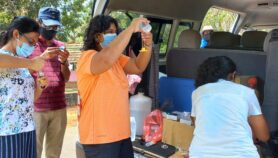Send to a friend
The details you provide on this page will not be used to send unsolicited email, and will not be sold to a 3rd party. See privacy policy.
[KARACHI] Abusive language and physical violence against doctors and other staff by patients' families are common in the emergency department and wards of Pakistan’s public hospitals, according to studies.
Research carried out in 2015 in Karachi’s hospitals by the International Committee of the Red Cross (ICRC), in collaboration with the Jinnah Sindh Medical University, included interviews with doctors, nurses, paramedics, non-medical hospital staff and law enforcement authorities that showed the enormity of the problem.
Medical practitioners said they felt scared, helpless and also demotivated. The findings of the study, released in November 2015, are in conformity with several earlier studies on violence in Pakistan’s hospitals.
Amjad Siraj Memon, professor of surgery at Karachi’s civil hospital, says a few years ago a group of armed young men wheeled in a man with severe head injuries and demanded that his brains, which they were carrying in a plastic bag, be replaced and the patient revived. “We were told to comply or face dire consequences," Memon tells SciDev.Net.
Scores of similarly hostile situations experienced by senior doctors were shared at an annual symposium in November 2015 at the Aga Khan University, Karachi. Most participants agreed that junior doctors, nurses and paramedics at the emergency department (ED) face some form of violence on a daily basis.
Explaining the complications of surgery and its risks, including death and maintaining clear documentation can prevent unrealistic expectations that patients and their relations may have.The first ever nation-wide study, conducted in 2011, on violence and abuse faced by junior physicians in the emergency departments of nine public hospitals in Pakistan showed that nearly 76.9 per cent of the 675 doctors interviewed had experienced violence — 65 per cent verbal and 11.9 per cent physical.
Male doctors were at a higher risk of facing violence than their female counterparts, according to the study. Most doctors said violence perpetrated on them affected their performance.
In a similar 2013 study involving 164 healthcare professionals, carried out in a public health care facility in Lahore, 74 per cent of the doctors said they had experienced violence in the year preceding the study with a majority of cases (76.8 per cent) taking place in the ED. The perpetrators were mostly patients' relatives (71 per cent).
Both the reports concluded that "too many" attendants, long waits, limited contact with the physician, resulted in chaos and mayhem and in turn led to violent incidents.
In the Lahore study, more than two-thirds of those interviewed reported violence while most of the others only disclosed it to colleagues. Lack of confidence that action would be taken (73 per cent) was the main reason for not reporting to the hospital administration. Some doctors assumed it came with the job (38.7 per cent).
The ICRC study found that most victims considered it useless to report abuse or were afraid of negative consequences. It observed that there was a need for intervention to address the behavioural, institutional and socio-political factors responsible for violence against health care practitioners.














